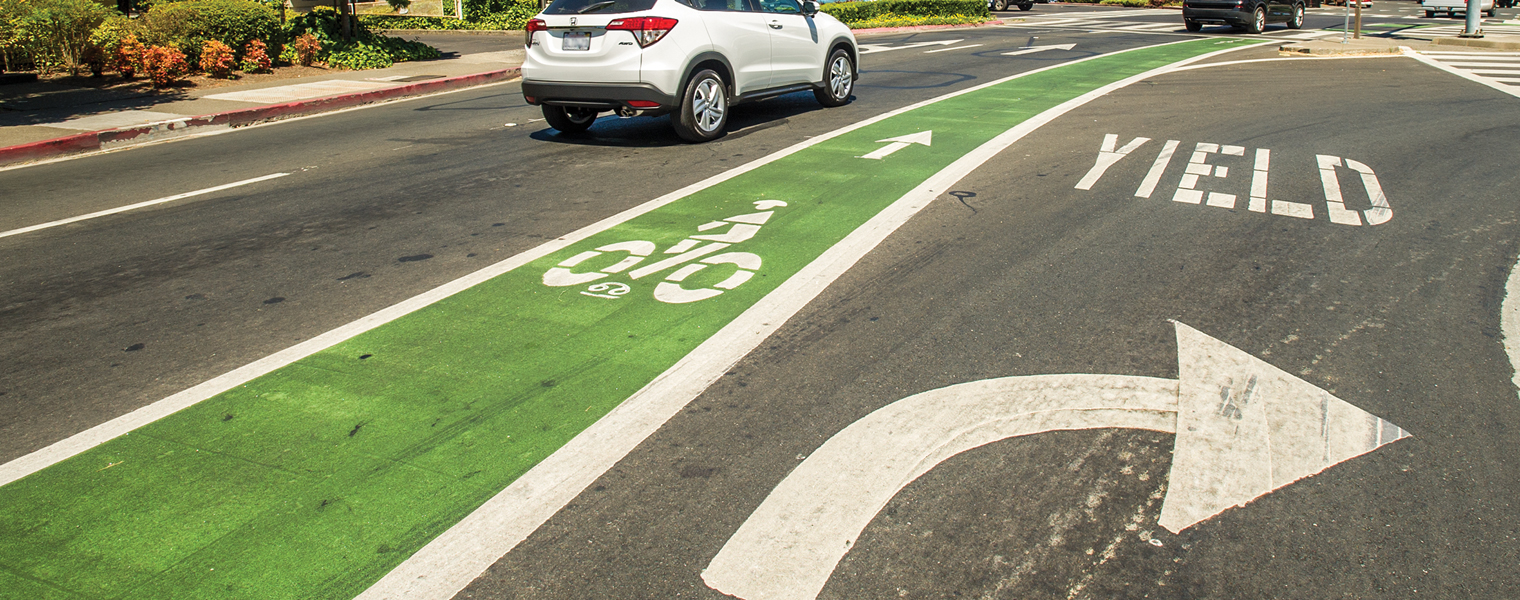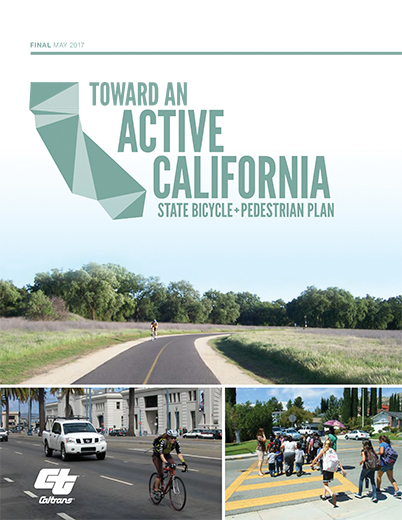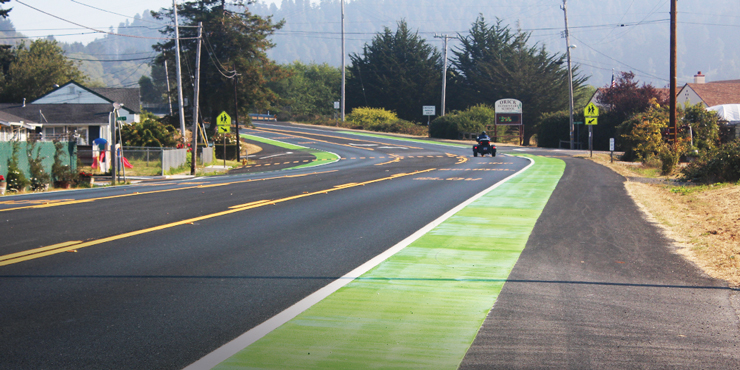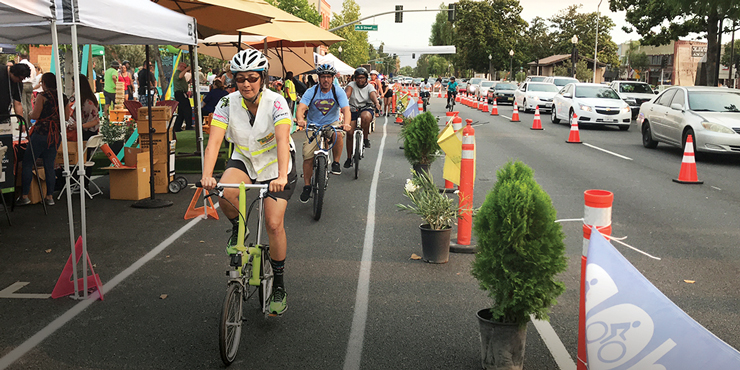Taking a Turn Toward Active Transportation
More Projects Around State Encourage Bicycling, Walking as a Means of Travel

Caltrans is committed to bike- and pedestrian-friendly transportation options and is working to strengthen and expand the network of routes, trails and facilities around the state. These “active transportation” projects to get people out of their cars help improve air quality, reduce congestion, promote healthy lifestyles, and provide travel alternatives for residents of disadvantaged communities.

Through the Active Transportation Program (ATP) created by legislation in 2013, more than $1 billion in state and local funds has been invested in the past five years to encourage modes of travel other than motorized vehicle. More than $200 million of that amount was generated by the Road Repair and Accountability Act of 2017 (Senate Bill 1) expressly for pedestrian and bicycle projects throughout California.
The development of active transportation projects in local communities is expected to grow in the next decade as SB 1 provides a larger, stable revenue source. SB 1 is projected to provide an additional $1 billion to the ATP through 2027 to build or improve existing bike paths, crosswalks and sidewalks. Caltrans’ Division of Local Assistance assists and oversees the delivery of local projects that receive ATP funds through the landmark transportation law and other sources.
Local agencies vie for ATP funds through a competitive process to promote non-auto transportation choices in their jurisdictions. Caltrans also can compete for funds through the ATP process to expand bike riding and walking options along the state highways. The California Transportation Commission sets the guidelines for each ATP funding cycle, selects the projects, and commits money to complete the work.
Caltrans districts and local agencies will be able to apply for ATP’s Cycle 5 funding, with the call for applications expected to be released this spring by the California Transportation Commission (CTC). About $445 million is projected to be available for local projects proposed through fiscal years 2021-2025. ATP funding comes from the federal government, SB 1 and the State Highway Account.
More than 800 ATP projects funded
Since its inception, the ATP program has funded more than 800 projects in rural and urban areas across the state. Many of these projects were developed with active transportation elements to protect students who walk and bike to school.
In addition to applying for ATP funds, Caltrans also uses the State Highway Operation and Protection Program (SHOPP) to add active transportation facilities as part of its overall road maintenance and rehabilitation work on the State Highway System. The SHOPP is a four-year master plan that lists Caltrans’ priority repair projects, and is updated every other year.
The most recent 2018 SHOPP plan reflects Caltrans’ support of active transportation goals. Of the almost $18 billion in projects scheduled through fiscal year 2021-22, Caltrans plans to construct more than 180,000 linear feet of sidewalks and crosswalks, 2,200 pedestrian safety features such as refuge islands, 640 linear miles of bicycle lanes and lane improvements, 130 linear miles of shoulder improvements, and 280 public transit features that provide better access to bus stops and rail stations.
Revenues from SB 1 is making more money available for upcoming projects, including active transportation, in the 2018 SHOPP. An additional $6.4 billion in projects of all types was programmed, or committed, over the plan’s four-year cycle.
An update to the SHOPP in 2020 should allow Caltrans to add even more meaningful active transportation improvements.
In each of the Department’s 12 regional districts, Caltrans Active Transportation Plans are being developed with local partner agencies and community-based organizations to identify cycling, pedestrian and transit improvements needed within each region’s boundaries. The number, and condition, of existing bicycle and pedestrian facilities along the State Highway System is now being collected as a part of that process.
Once the inventory is complete, Caltrans districts will work with local partners to identify high-priority gaps in the system and opportunities to upgrade existing facilities and determine the cost of needed improvements. In addition to building a comfortable and convenient system for people to walk and bicycle, the districts must initiate projects that enhance safety, be long-lasting, and serve communities that have been bypassed, divided or negatively impacted by previous transportation investments.

Considering all road users
The goal of increasing walking and bicycling in California was formalized at Caltrans in 2008 with the adoption of a Complete Streets Policy. The Complete Streets internal directive widened the Department’s transportation focus to accommodate the movement of people walking or cycling to their destinations.
Under Caltrans Complete Streets Policy, designated state highways such as main streets in smaller communities or arterial streets in suburban or urban communities are considered for design makeovers when other repaving, maintenance, or bridge work is planned that will create safe environments for all road users, including bicyclists, pedestrians, transit vehicles, truckers and motorists. The kind of changes that go into creating a “complete street” depends on context, community preferences, identified safety concerns, and the types of road users and their needs.
In May 2017, the Department released the state’s first pedestrian and bicycle plan, ‘Toward an Active California.” Its vision statement is, “By 2040, people in California of all ages, abilities and incomes can safely, conveniently, and comfortably walk and bicycle for their transportation needs.”
Caltrans reaffirmed its commitment to a sustainable transportation system in its 2015-2020 Strategic Management Plan, calling for an increase statewide in non-motorized travel. Although the rates of bicycling and walking in California are not meeting those targets, according to recent surveys, Caltrans is dedicated to creating more new and safe alternative modes of travel. More on that topic in a future Mile Marker issue.
Sources: Caltrans Sustainability Program, Caltrans Division of Local Assistance, Caltrans 2019 State Highway System Management Plan, “Toward an Active California” State Bicycle and Pedestrian Plan, California Transportation Commission.
Green Travel Projects Take Root in Caltrans Districts
Here is a sampling of projects and initiatives in Caltrans regional districts throughout the state that promote walking and cycling. Caltrans’ role in these and other similar projects involves either planning, consultation with local agencies, funding, coordination and oversight of projects.

District 1
Caltrans District 1 in June 2018 installed green shoulder markings to encourage bicycle use and protect riders in the community of Orick, in Humboldt County. That project was initiated as part of an earlier report that Caltrans helped fund on improving the town’s sense of place as a gateway to the redwoods.
District 2
District 2 is coordinating with the city of Redding to deliver a project that will close Riverside Drive to through traffic. The project will provide continuous bike lanes along the roadway, connecting the existing paved River Trail system to downtown, neighborhoods, schools, businesses and various services, and close gaps in sidewalks for those walking and biking. Additional coordination is being made with the city to permit a two-way cycle track on State Route 273 that connects the Riverside Drive project to a second effort that Redding is moving forward with that will offer affordable housing and a marketplace in the downtown promenade area, which is becoming a destination place for active transportation enthusiasts.
District 3
In a project that finished in February 2018, District 3 oversaw widening of both shoulders on Butte House Road in Yuba City to accommodate an eight-foot, Class II (defined by a painted stripe) bike lane between Royo Ranchero Drive and Madison Road. The project included all associated striping and signage improvements. This project also closed a gap between existing bicycle facilities, and there has been an observable increase in bicycling along the revamped stretch.
District 4
In District 4 last fall, Caltrans completed repaving work on two one-way portions of State Route 116 in Sebastopol. The Department worked with the city to implement a partial “road diet” that features new bike lanes designated by green conflict zone markings and a striped buffer. Some residents were initially hesitant about the repainted lanes, but have come to learn that solid green paths are bike-only, and fragmented green lanes mean vehicles can cross over them.
District 5
What began as a straightforward resurfacing project in District 5 flowered into something much more last summer in Los Alamos. Due to community involvement, Class II (painted stripe) bikeways, bike lane buffers and enhanced-visibility crosswalks were incorporated into the project, as were curb ramps upgraded to meet American With Disabilities Act requirements. The project encompassed about a half-mile of State Route 135 (which connects to Highway 101).
District 6
A project that will add eight miles of bicycle lanes, provide enhanced crosswalk visibility, and make accessibility and school safety route improvements is in the design phase for SR 184 near the city of Bakersfield. In Woodlake, Tulare County, construction of a new roundabout was wrapped up about a year ago. The roundabout features bike lanes, wide decorative sidewalks, street “furniture,” landscaping and decorative lighting, where SRs 245 and 216 intersect.
District 7
In the District 7 college town of Claremont a few blocks north of Old Route 66, Caltrans last summer finished a green bicycle lane project on the southbound side of North Towne Avenue as it crosses over Interstate 210. The project was funded by a local agency, and Caltrans issued an encroachment permit. The project was paid for through a Safe Routes to School grant.

District 8
On a festive day in August 2018, District 8 helped plan and participated in a Complete Streets demonstration event along Upland’s Euclid Avenue, which as State Route 83 is maintained by Caltrans. A Class IV cycle track (a bike lane separated by a physical barrier), curb extensions (shortening pedestrian crossing distance) and parklets (enhanced sidewalk seating areas in place of a parking space) were temporarily placed on the streets to promote a permanent street-safety makeover. More than 1,200 people attended the event in Upland.
District 9
In cooperation with the town of Mammoth Lakes, District 9 developed, funded and constructed a retaining wall, curb, gutter, lighting and sidewalk on a portion of State Route 203 (Main Street) between the Old Mammoth area and the “Mammoth Village” — a heavily visited center for the town, the eastern Sierra and Mammoth Mountain Ski Area. Prior to the project, finished in fall 2018, pedestrians walked on the busy road’s shoulder, and for much of the year had to navigate their way through snowpiles.
District 10
Projects that added or improved pedestrian/bicyclist facilities, or Complete Streets features, were started or completed in 2019 on sections of State Route 12 in the Sacramento-San Joaquin Delta, SRs 16, 49, 88 and 104 in the Sierra Nevada foothills, SR 99 overpasses in Lodi and Ripon, and the SR 120/108 junction east of Oakdale, a main turnoff for Yosemite National Park.
District 11
With the opening of the I-5 Gilman Bridge in February, District 11 reached a major milestone for the Interstate 5 Build North Coast Corridor Program (Build NCC). In partnership with the University of California, San Diego, Caltrans built a bridge over the freeway that connects the east and west campuses. It gives students, faculty and visitors easier access to the university and the surrounding community. In addition, there is no longer a need to use city streets or the highway to get to any point once on campus. The bridge includes a protected left turn pocket, bike lanes and sidewalks. The Build NCC is part of a 40-year, $6 billion multi-agency project that balances transportation improvements with environmental enhancement programs to ensure better mobility and more transportation choices in the San Diego area.
District 12
In Orange County, work is now underway on restriping Culver Drive at the Interstate 405 overcrossing to create a new Class II bicycle lane. The project began last April, and is scheduled to wrap up in January 2020. A more extensive restriping effort along State Route 1, the Pacific Coast Highway, is now in the planning stages, a 15-mile stretch starting on Dover Drive and finishing at the Los Angeles County line.

